If you haven't been keeping up with the Trials, here are a few of the highlights from the first four days. The photos come from a variety of online sources, including the Oregonian and Track and Field News.
Places and Standards - I want to make a distinction that often confuses those don't work in track and field on a regular basis. The common understanding is that the athletes who finish in the top three places in an event will represent the US at the Olympics in London. But that is only true if they hold the necessary Olympic "A" qualifying mark in their event. In some cases, an athlete may finish in the top three but have to stay home. For instance, in the women's 10,000 meters, the athletes who finished first, fourth, and seventh here in Eugene will go to London. The second-place finisher does not have the "A" standard and the third-place finisher (who does have the "A" standard) will run the marathon instead of the 10,000 in London. The women who finished fourth and seventh are highest placers with the "A" standard.
Hammertime - The Trials actually began before the meet officially began with the hammer competitions. If you are not familiar with the hammer, it is a facsinating event. Think of a shot put at the end of a three foot wire cable and thrown over 2/3 the length of a football field. These were held the day before the meet actually started on the Nike campus in Beaverton, OR. The hope was that moving the event to its own separate time and place would generate more attention to the event (and open up more room in Eugene to park television trucks). Hammertime did draw a larger and more enthusiastic crowd than they probably would have in Eugene and the reports from officials and athletes all seem to be positive.
Rain - There really aren't many places better for a major track meet than Eugene, OR. The facilities are great and they draw large, enthusiastic, and knowledgeable crowds. But Oregon also gets rain, and that has been a major story line (especially in the pole vaults) through the first half of the Trials.
Ashton Easton - I love the Combined Events and appreciate the athletes that compete in them. There is a comradery among them that is rare in athletics at this high of a level. But they realize that their primary competition is them vs. the event. So they support and encourage one another in a way that is unique. And the main story of the Trials to this point as to be Ashton Eaton. On Saturday, the 24 year-old University of Oregon graduate broke the world decathlon record (held for the past eleven years by Romen Sebrle of the Czech Republic) by scoring 9,039 points in conditions that were often less than ideal. I also appreciated the acts of sportsmanship demonstrated by some of his competitors as Ashton approached the final event - the 1,500 run. Realizing that Ashton had the victory wrapped up but that he needed to run the 1,500 considerable faster than he had ever run it before to break the world record, the two best 1,500 runners among the decathletes - Joe Detmer and Curtis Beach - chose to run with Ashton, encouraging and "pushing" him. Then, as they neared the finish line, rather than racing ahead (which they could have easily done), they backed off and let Ashton cross the line first with the new world record. It was all a very moving display of sportsmanship by Joe and Curtis and a great display of athletic ability by Ashton. And he is still probably several years away from this athletic peak.
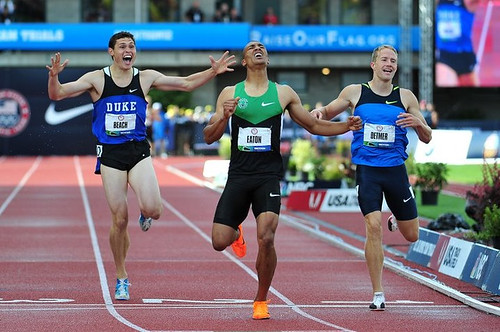 A Dead Heat - During women's 100 meter dash final on Saturday, the unthinkable happened. Two athletes - Allyson Felix and Jeneba Tarmoh - tied for third place (and the final spot of the Olympic Team). First of all, to have two athletes tie in a race to the 1/1000 of a second is very rare. But, in most cases, it wouldn't be a big deal. They would be listed as tied for third place and you would move on. But in this case, this also meant who would or wouldn't make the US Olympic Team. There is only room for one of them to go. And USA Track and Field had no procedure in place to break that tie, because this is more of an administrative issue (who makes the team) versus a competitive issue (who finished third, they both did). It took them a couple of days to figure out a tie-breaking solution and they won't actually break the tie until next weekend. The whole process left USATF open to some criticism along the way. By the way, you need to read this interview from Sports Illustrated with my friends Roger Jennings and Bob Podkaminer. It will explain the whole scenario in more detail and it is really interesting.
A Dead Heat - During women's 100 meter dash final on Saturday, the unthinkable happened. Two athletes - Allyson Felix and Jeneba Tarmoh - tied for third place (and the final spot of the Olympic Team). First of all, to have two athletes tie in a race to the 1/1000 of a second is very rare. But, in most cases, it wouldn't be a big deal. They would be listed as tied for third place and you would move on. But in this case, this also meant who would or wouldn't make the US Olympic Team. There is only room for one of them to go. And USA Track and Field had no procedure in place to break that tie, because this is more of an administrative issue (who makes the team) versus a competitive issue (who finished third, they both did). It took them a couple of days to figure out a tie-breaking solution and they won't actually break the tie until next weekend. The whole process left USATF open to some criticism along the way. By the way, you need to read this interview from Sports Illustrated with my friends Roger Jennings and Bob Podkaminer. It will explain the whole scenario in more detail and it is really interesting.Come-backs, Young Guns, and the Women's Vault - Sunday found a lot of exciting competition in both track and field. On the track, Justin Gatlin and Tyson Gay finished one and two in the men's 100 meter dash. This was a comeback for both of them. Six years ago, Gatlin began a four-year suspension for using performance enhancing drugs. On Sunday, he won a US Championship, a spot in the London Olympics by running as fast (or faster) than he ever has. Tyson, who finished second, did it in just his fourth race back after having hip surgery and not running for almost a year. He should be in even better condition when the Olympics come around. In the men's long jump, "youngsters" Will Claye and Marquis Grissom battled back and forth with Claye grabbing the lead on his final jump only to see Grissom take it back on the very next jump. Both men are great pressure jumpers. Finally, Sunday also had the women's pole vault final. Three women with ties to the Razorbacks were entered. Katie Stripling Tannehill no-heighted while Janice Keppler tied for ninth and April Steiner Bennett (who make the 2008 Olympic team) tied for fifth.
Men's High Jump Final - Though we had officiated the decathlon high jump and the men's qualifying round earlier, our crew had its first final on Monday with the men. We again faced wet conditions, but our crew and the facility crew at Hayward Field did a great job of keeping water off of the apron so that the athlete's could jump without slipping. The wet conditions kept the athletes from jumping exceedingly high, but it was a very exciting competition won by 35 year-old Jamie Nieto. Jamie won the 2004 US Olympic Trials and went on to place fourth in the London Olympics. In 2008, Jamie finished tied for second at the Trials but did not have the necessary Olympic "A" standard (see above) and so he didn't get to go to Beijing. But this year, he has both the standard and the victory and will be going to London, along with Eric Kinyard (a great young jumper from Kansas State) and Jesse Williams, the defending world champion. Jesse actually finished fourth - but the third-place finished didn't have the "A" standard. And one final high jump note: all three members of our men's Olympic high jump squad are coached by Cliff Rovelto, head coach at Kansas State University.
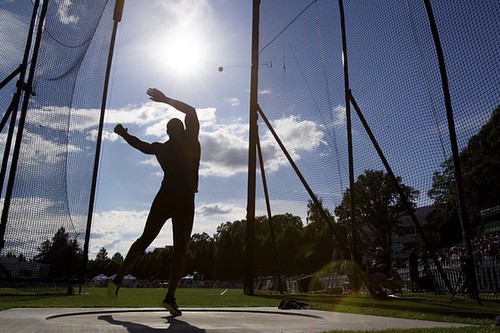
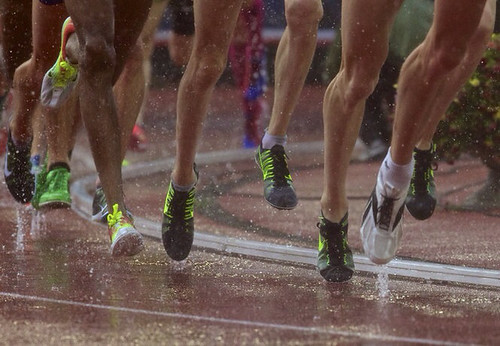
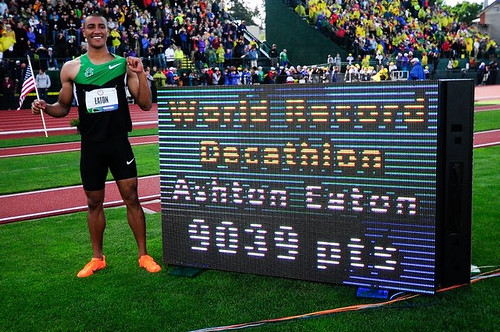
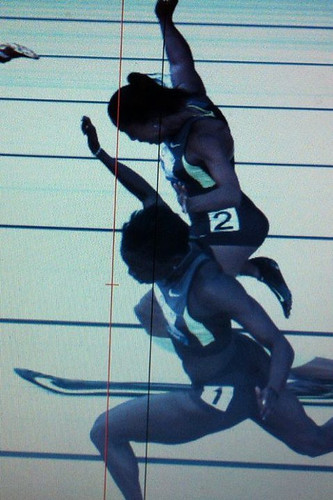
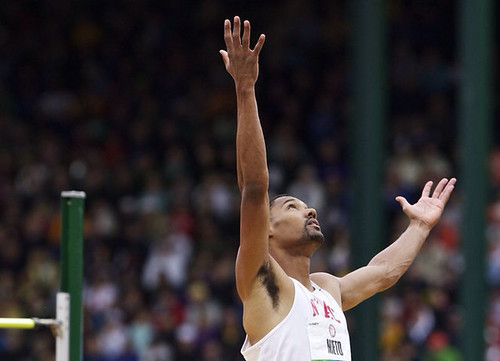
No comments:
Post a Comment